
Starting Strength Gyms
How much does Starting Strength Gyms cost?
Initial Investment Range
$237,033 to $772,428
Franchise Fee
$45,787 to $111,797
Strength Train LLC offers for sale a franchise to establish and operate a gym that focuses on a strength training system identified by the “Starting Strength” trade name and marks.
Enjoy our partial free risk analysis below
Unlock the full risk analysis to access 9 more categories covering 100+ risks.
Starting Strength Gyms May 16, 2025 FDD Risk Analysis
Free FDD Library AI Analysis Date: August 22, 2025
DISCLAIMER: Not Legal Advice - For Informational Purposes Only. Consult With Qualified Franchise Professionals.
Franchisor Stability Risks
Start HereDisclosure of Franchisor's Financial Instability
High Risk
Explanation
The franchisor, Strength Train LLC (Strength Train), shows significant signs of financial weakness. Its audited financial statements reveal a members' deficit (negative net worth) of over $720,000 as of year-end 2024, with total liabilities far exceeding total assets. The company also took on a significant loan from a member in 2024 to continue operations. This financial state, also noted as a Special Risk by the franchisor, questions its ability to support you or sustain itself.
Potential Mitigations
- A thorough review of the franchisor's financial statements, including all footnotes and the auditor's report, with your accountant is essential.
- Your attorney should advise on the implications of state-mandated fee deferrals imposed due to the franchisor's financial condition.
- It is critical to discuss the franchisor's capitalization and turnaround plan with a business advisor before making any commitment.
High Franchisee Turnover
High Risk
Explanation
Item 20's data reveals a significant risk, as three franchisees ceased operations due to bankruptcy in the 2024 fiscal year. Out of 22 franchises at the start of the year, this represents a failure rate of over 13%. Such a high rate of bankruptcy within the system is a strong indicator of potential systemic problems, such as a lack of profitability or an unviable business model for franchisees, which could directly impact your potential for success.
Potential Mitigations
- Contacting former franchisees, especially those listed as having ceased operations, is crucial to understand the reasons for their failure.
- Your accountant must use this turnover data to critically assess the financial viability and risks of the business model.
- A discussion with your attorney is necessary to understand if there are systemic issues that could lead to disputes or failure.
Rapid System Growth
Medium Risk
Explanation
The franchise system is growing, expanding from 17 to 25 operating units between the start of 2023 and the end of 2024. While growth can be positive, when combined with the franchisor's stated financial instability and high franchisee bankruptcy rate, it raises concerns about whether Strength Train can adequately support this expansion. Resources may be stretched thin, potentially affecting the quality of training, site selection assistance, and ongoing operational support available to you.
Potential Mitigations
- Questioning the franchisor about their specific plans to scale support infrastructure in line with unit growth is an important step.
- Engage a business advisor to assess whether the franchisor's current structure can sustain its growth and support new units effectively.
- Speaking with both new and established franchisees can provide insight into whether support levels are declining as the system grows.
New/Unproven Franchise System
High Risk
Explanation
Although the franchise began operating in 2018, its high franchisee bankruptcy rate and poor financial condition suggest the business model's long-term viability is not yet proven. A critical risk factor is that Strength Train discloses in Item 1 that it has never operated a corporate-owned gym itself. This lack of direct operational experience may impact the quality of its systems and support, as it has not tested its own model as an operator.
Potential Mitigations
- A business advisor can help you evaluate the risks associated with a franchisor that has no corporate operating history.
- Speaking with a wide range of current franchisees about the system's operational effectiveness is essential due diligence.
- Your accountant should carefully model profitability scenarios, given the lack of a proven corporate track record and recent franchisee failures.
Possible Fad Business
Low Risk
Explanation
This risk was not identified in the FDD package. The business model, focused on strength training, is part of the well-established fitness industry and is not based on a recent or fleeting trend. However, you should always assess if a concept has long-term consumer demand in your specific market, as market preferences can shift over time, impacting the viability of any business, regardless of how established the broader industry is.
Potential Mitigations
- A business advisor can help you research long-term consumer demand and the competitive landscape for this type of fitness service in your area.
- Your financial projections, created with an accountant, should consider potential shifts in market trends over the 10-year franchise term.
- Discuss the franchisor's plans for innovation and adaptation to stay relevant with existing franchisees.
Inexperienced Management
High Risk
Explanation
A significant risk disclosed in Item 1 is that Strength Train does not and has never operated a company-owned gym. This means management lacks direct, hands-on experience running the very business they are franchising. While Item 2 shows executives have industry experience, there is a distinct difference between being a coach or consultant and being an operator. This lack of practical operational experience could affect the quality and relevance of their support, training, and systems.
Potential Mitigations
- It is crucial to speak with current franchisees to gauge the quality and practicality of the support and systems provided.
- A business advisor can help you assess the potential gaps that may arise from a management team with no direct operational experience.
- Your attorney should be aware of this risk when reviewing the franchisor's stated obligations to provide operational support.
Private Equity Ownership
Low Risk
Explanation
This risk was not identified in the FDD package. Item 1 indicates the franchisor does not have a parent company and does not appear to be owned by a private equity firm. Business decisions seem to be made by the founding members. However, it is always wise to understand the ownership structure of any franchise, as a future sale to a private equity firm could change the system's priorities.
Potential Mitigations
- Your attorney should confirm the ownership structure and review any clauses in the Franchise Agreement regarding the franchisor's right to sell the system.
- During franchisee calls, you can ask about their perception of the franchisor's long-term goals and commitment to the brand.
- A business advisor can explain the typical strategic differences between founder-led companies and those owned by investment firms.
Non-Disclosure of Parent Company
Low Risk
Explanation
This risk was not identified in the FDD package. Strength Train LLC is presented as the primary entity, and no parent company is mentioned. The financial statements provided are for Strength Train LLC itself. Therefore, the risk of a parent company's finances being hidden while being critical to the system's stability does not appear to be present here.
Potential Mitigations
- Your attorney can perform a corporate search to confirm the ownership structure and lack of an undisclosed parent entity.
- An accountant should still review the provided financials for any guarantees or support obligations from related parties that might imply a parent-like relationship.
- Asking the franchisor directly to confirm there is no parent company is a reasonable due diligence step.
Predecessor History Issues
Low Risk
Explanation
This risk was not identified in the FDD package. Item 1 of the FDD explicitly states, "We have no predecessors." This means the current franchisor, Strength Train LLC, did not acquire the franchise system from a prior company, and you do not need to be concerned about a hidden history of failure or litigation from a previous owner of the brand.
Potential Mitigations
- Your attorney can confirm this statement by reviewing the corporate history of the franchisor.
- While there is no predecessor, discussing the franchisor's own history with early franchisees remains a vital part of due diligence.
- A business advisor can help you evaluate the franchisor's track record since its inception in 2018.
Pattern of Litigation
Low Risk
Explanation
This risk was not identified in the FDD package. Item 3 states, "No litigation is required to be disclosed in this Item." This suggests there is no current or recent history of significant lawsuits involving the franchisor, its management, or its franchisees, which is a positive sign. However, the lack of disclosed litigation does not guarantee a dispute-free system.
Potential Mitigations
- Your attorney can conduct an independent search of public court records to verify the absence of significant litigation.
- When speaking with current and former franchisees, it is still prudent to ask about any disputes they may be aware of, even if they didn't result in a lawsuit.
- Understanding the dispute resolution process outlined in Item 17 with your lawyer is important for any future disagreements.
Disclosure & Representation Risks
Example Risk: Franchisee Financial Obligations
Blue Risk
Explanation
This risk involves the financial obligations that a franchisee must meet, including initial fees, ongoing royalties, and other required payments. Understanding these obligations is crucial for long-term success.
Potential Mitigations
- Carefully review the Franchise Disclosure Document (FDD) and consult with a franchise attorney to fully understand all financial commitments before signing.
- Conduct regular risk assessments
- Implement monitoring and reporting systems
Unlock Full Risk Analysis
Purchase the complete risk review to see all 102 risks across all 10 categories.
Financial & Fee Risks
Example Risk: Franchisee Financial Obligations
Blue Risk
Explanation
This risk involves the financial obligations that a franchisee must meet, including initial fees, ongoing royalties, and other required payments. Understanding these obligations is crucial for long-term success.
Potential Mitigations
- Carefully review the Franchise Disclosure Document (FDD) and consult with a franchise attorney to fully understand all financial commitments before signing.
- Conduct regular risk assessments
- Implement monitoring and reporting systems
Unlock Full Risk Analysis
Purchase the complete risk review to see all 102 risks across all 10 categories.
Legal & Contract Risks
Example Risk: Franchisee Financial Obligations
Blue Risk
Explanation
This risk involves the financial obligations that a franchisee must meet, including initial fees, ongoing royalties, and other required payments. Understanding these obligations is crucial for long-term success.
Potential Mitigations
- Carefully review the Franchise Disclosure Document (FDD) and consult with a franchise attorney to fully understand all financial commitments before signing.
- Conduct regular risk assessments
- Implement monitoring and reporting systems
Unlock Full Risk Analysis
Purchase the complete risk review to see all 102 risks across all 10 categories.
Territory & Competition Risks
Example Risk: Franchisee Financial Obligations
Blue Risk
Explanation
This risk involves the financial obligations that a franchisee must meet, including initial fees, ongoing royalties, and other required payments. Understanding these obligations is crucial for long-term success.
Potential Mitigations
- Carefully review the Franchise Disclosure Document (FDD) and consult with a franchise attorney to fully understand all financial commitments before signing.
- Conduct regular risk assessments
- Implement monitoring and reporting systems
Unlock Full Risk Analysis
Purchase the complete risk review to see all 102 risks across all 10 categories.
Regulatory & Compliance Risks
Example Risk: Franchisee Financial Obligations
Blue Risk
Explanation
This risk involves the financial obligations that a franchisee must meet, including initial fees, ongoing royalties, and other required payments. Understanding these obligations is crucial for long-term success.
Potential Mitigations
- Carefully review the Franchise Disclosure Document (FDD) and consult with a franchise attorney to fully understand all financial commitments before signing.
- Conduct regular risk assessments
- Implement monitoring and reporting systems
Unlock Full Risk Analysis
Purchase the complete risk review to see all 102 risks across all 10 categories.
Franchisor Support Risks
Example Risk: Franchisee Financial Obligations
Blue Risk
Explanation
This risk involves the financial obligations that a franchisee must meet, including initial fees, ongoing royalties, and other required payments. Understanding these obligations is crucial for long-term success.
Potential Mitigations
- Carefully review the Franchise Disclosure Document (FDD) and consult with a franchise attorney to fully understand all financial commitments before signing.
- Conduct regular risk assessments
- Implement monitoring and reporting systems
Unlock Full Risk Analysis
Purchase the complete risk review to see all 102 risks across all 10 categories.
Operational Control Risks
Example Risk: Franchisee Financial Obligations
Blue Risk
Explanation
This risk involves the financial obligations that a franchisee must meet, including initial fees, ongoing royalties, and other required payments. Understanding these obligations is crucial for long-term success.
Potential Mitigations
- Carefully review the Franchise Disclosure Document (FDD) and consult with a franchise attorney to fully understand all financial commitments before signing.
- Conduct regular risk assessments
- Implement monitoring and reporting systems
Unlock Full Risk Analysis
Purchase the complete risk review to see all 102 risks across all 10 categories.
Term & Exit Risks
Example Risk: Franchisee Financial Obligations
Blue Risk
Explanation
This risk involves the financial obligations that a franchisee must meet, including initial fees, ongoing royalties, and other required payments. Understanding these obligations is crucial for long-term success.
Potential Mitigations
- Carefully review the Franchise Disclosure Document (FDD) and consult with a franchise attorney to fully understand all financial commitments before signing.
- Conduct regular risk assessments
- Implement monitoring and reporting systems
Unlock Full Risk Analysis
Purchase the complete risk review to see all 102 risks across all 10 categories.
Miscellaneous Risks
Example Risk: Franchisee Financial Obligations
Blue Risk
Explanation
This risk involves the financial obligations that a franchisee must meet, including initial fees, ongoing royalties, and other required payments. Understanding these obligations is crucial for long-term success.
Potential Mitigations
- Carefully review the Franchise Disclosure Document (FDD) and consult with a franchise attorney to fully understand all financial commitments before signing.
- Conduct regular risk assessments
- Implement monitoring and reporting systems
Unlock Full Risk Analysis
Purchase the complete risk review to see all 102 risks across all 10 categories.











